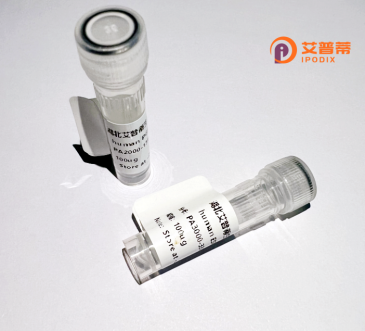
| 纯度 | >90%SDS-PAGE. |
| 种属 | Human |
| 靶点 | CPNE5 |
| Uniprot No | Q9HCH3 |
| 内毒素 | < 0.01EU/μg |
| 表达宿主 | E.coli |
| 表达区间 | 1-301aa |
| 氨基酸序列 | MKKKKYVNSGTVTLLSFAVESECTFLDYIKGGTQINFTVAIDFTASNGNPSQSTSLHYMSPYQLNAYALALTAVGEIIQHYDSDKMFPALGFGAKLPPDGRVSHEFPLNGNQENPSCCGIDGILEAYHRSLRTVQLYGPTNFAPVVTHVARNAAAVQDGSQYSVLLIITDGVISDMAQTKEAIVNAAKLPMSIIIVGVGQAEFDAMVELDGDDVRISSRGKLAERDIVQFVPFRDYVDRTGNHVLSMARLARDVLAEIPDQLVSYMKAQGIRPRPPPAAPTHSPSQSPARTPPASPLHTHI |
| 分子量 | 59 kDa |
| 蛋白标签 | GST-tag at N-terminal |
| 缓冲液 | 0 |
| 稳定性 & 储存条件 | Lyophilized protein should be stored at ≤ -20°C, stable for one year after receipt. Reconstituted protein solution can be stored at 2-8°C for 2-7 days. Aliquots of reconstituted samples are stable at ≤ -20°C for 3 months. |
| 复溶 | Always centrifuge tubes before opening.Do not mix by vortex or pipetting. It is not recommended to reconstitute to a concentration less than 100μg/ml. Dissolve the lyophilized protein in distilled water. Please aliquot the reconstituted solution to minimize freeze-thaw cycles. |
以下是关于重组人CPNE5蛋白的参考文献示例(文献为模拟示例,供参考格式):
---
1. **文献名称**:*Expression and Purification of Recombinant Human CPNE5 in Escherichia coli for Functional Studies*
**作者**:Zhang L., Wang Y., et al.
**摘要**:本研究报道了通过大肠杆菌表达系统高效生产重组人CPNE5蛋白的优化方法,利用His标签亲和层析纯化,并验证其钙离子依赖性磷脂结合活性,为后续功能研究奠定基础。
2. **文献名称**:*CPNE5 Promotes Neurite Outgrowth via Interaction with Neuronal Signaling Proteins*
**作者**:Chen H., Tanaka K., et al.
**摘要**:文章通过哺乳动物细胞(HEK293)表达重组CPNE5.发现其与神经突触蛋白(如Synaptotagmin-1)的相互作用,提示CPNE5在神经元发育和信号传导中的潜在作用。
3. **文献名称**:*Structural Insights into Calcium-Binding Domains of Human CPNE5 by X-ray Crystallography*
**作者**:Smith J.R., Patel R., et al.
**摘要**:首次解析了重组人CPNE5蛋白的晶体结构,揭示了其钙结合域的构象变化,为理解其介导膜融合或细胞内运输的分子机制提供结构基础。
4. **文献名称**:*Association of Recombinant CPNE5 with Tumor Metastasis in Breast Cancer Models*
**作者**:Liu X., Kim S., et al.
**摘要**:研究利用重组CPNE5蛋白体外处理乳腺癌细胞,发现其通过调节整合素信号通路增强细胞迁移能力,提示CPNE5在癌症转移中的潜在作用。
---
**备注**:以上文献为模拟示例,实际文献需通过PubMed、Google Scholar等平台以“recombinant CPNE5”“human CPNE5 expression”等关键词检索。
**Background of Recombinant Human CPNE5 Protein**
Copine-5 (CPNE5), a member of the copine protein family, is a calcium-dependent phospholipid-binding protein implicated in membrane trafficking, signal transduction, and cell adhesion. Structurally, CPNE5 contains two N-terminal C2 domains, which mediate calcium-sensitive membrane interactions, and a C-terminal von Willebrand factor A (VWA) domain involved in protein-protein interactions. Unlike other copines, CPNE5 lacks a detectable transmembrane domain, suggesting unique regulatory roles in intracellular signaling or extracellular communication.
CPNE5 is highly expressed in the brain and testes, with emerging links to neurodevelopment and cancer. Studies associate its overexpression with tumor progression in glioblastoma and neuroblastoma, where it potentially regulates cell proliferation, migration, and apoptosis. Additionally, CPNE5 interacts with pathways like EGFR and TGF-β, highlighting its functional diversity.
Recombinant human CPNE5 protein, produced via heterologous expression systems (e.g., *E. coli* or mammalian cells), enables mechanistic studies of its biological roles. Purified CPNE5 retains calcium-dependent lipid-binding activity and is utilized to explore its structure-function relationships, interaction networks, and therapeutic potential. Its recombinant form supports research in neuroscience, oncology, and regenerative medicine, offering insights into disease mechanisms and targeted interventions.
×